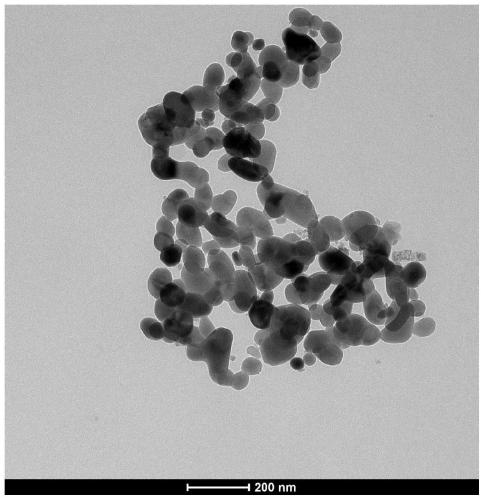Method for preparing yttrium aluminum garnet nanoparticles
A technology of yttrium aluminum garnet and nanoparticles, which is applied in the direction of nanotechnology, nanotechnology, chemical instruments and methods, etc., can solve the problems of complex process, inability to synthesize YAG pure phase, and difficulty in highly dispersing YAG nanoparticles, and achieve the preparation method The effect of simplicity and ease of mass production
- Summary
- Abstract
- Description
- Claims
- Application Information
AI Technical Summary
Problems solved by technology
Method used
Image
Examples
Embodiment 1
[0030] Example 1: Aluminum nitrate, yttrium nitrate and citric acid were dissolved in ethylene glycol methyl ether to prepare organosol, wherein the molar concentration of aluminum was 0.1M, and the molar ratio of aluminum nitrate, yttrium nitrate and citric acid was 5:3:1 . Mix the organosol and potassium sulfate, and pour off the excess organosol after sedimentation to obtain a mixture of the organosol and potassium sulfate. The mixture was kept at 60°C to 120°C and dried to obtain a loose powder. The powder is calcined at 600° C. to below the melting point of potassium sulfate, and the calcined product is washed with water and dried to obtain yttrium aluminum garnet nanoparticles.
Embodiment 2
[0031] Example 2: Aluminum nitrate, yttrium nitrate and citric acid were dissolved in ethylene glycol methyl ether to prepare organosol, wherein the molar concentration of aluminum was 0.1M, and the molar ratio of aluminum nitrate, yttrium nitrate and citric acid was 5:3:1 . Mix the organosol with sodium sulfate, and pour off the excess organosol after sedimentation to obtain a mixture of the organosol and potassium sulfate. The mixture was kept at 60°C to 120°C and dried to obtain a loose powder. The powder is calcined at 600° C. to below the melting point of sodium sulfate, and the calcined product is washed with water and dried to obtain yttrium aluminum garnet nanoparticles.
Embodiment 3
[0032] Example 3: Aluminum nitrate, yttrium nitrate and citric acid were dissolved in ethylene glycol methyl ether to prepare organosol, wherein the molar concentration of aluminum was 0.1M, and the molar ratio of aluminum nitrate, yttrium nitrate and citric acid was 5:3:1 . Mix the organic sol with potassium chloride, and pour off the excess organic sol after sedimentation to obtain a mixture of the organic sol and potassium sulfate. The mixture was kept at 60°C to 120°C and dried to obtain a loose powder. The powder is calcined at 600° C. to below the melting point of potassium chloride, and the calcined product is washed with water and dried to obtain yttrium aluminum garnet nanoparticles.
PUM
 Login to View More
Login to View More Abstract
Description
Claims
Application Information
 Login to View More
Login to View More - R&D
- Intellectual Property
- Life Sciences
- Materials
- Tech Scout
- Unparalleled Data Quality
- Higher Quality Content
- 60% Fewer Hallucinations
Browse by: Latest US Patents, China's latest patents, Technical Efficacy Thesaurus, Application Domain, Technology Topic, Popular Technical Reports.
© 2025 PatSnap. All rights reserved.Legal|Privacy policy|Modern Slavery Act Transparency Statement|Sitemap|About US| Contact US: help@patsnap.com

